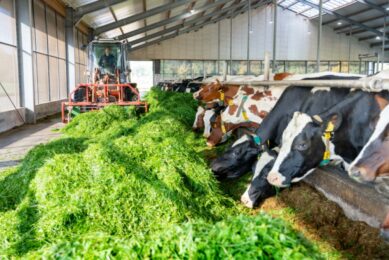Sustainable feed choices require valid LCA values

An increasing number of ingredients and feed additives used in compound feed and premixes now come with verified LCA values. Backed with new formulations and modelling tools, these values are key to evaluate and lower the total carbon emissions of feed and livestock operations.
SUSTAINABILITY & WELFARE SPECIAL 2024 – read all articles
Achieving the most sustainable animal production system is about optimising nutrition, health, genetics, and farm management. Animal feed is an important and fundamental link that can make a major contribution (40-80%) to the total emissions emitted by animal-based food production. This is because the production of feed ingredients and compound feed involves land use, transportation, high energy use for feed processing and more.
More accurate LCA data
To be able to make the right diet decisions and provide appropriate data for various sustainability modelling programmes and carbon footprint labels, you need accurate data. And this data is increasingly becoming available. Not only for raw materials, but also for feed additives, premixes, and compound feeds. The data comes from a regulated process referred to as a Life Cycle Assessment (LCA). Once verified by a third-party reviewer, the LCA can be stored in databases such as the GFLI, and FAO. An LCA looks closely at many different factors that influence the environmental impact of a product and/or practice. In livestock production and animal nutrition, we mainly look at the total carbon emissions, (what is topically called the carbon footprint, measured as CO2 eq per unit of animal productivity (measured as Kgs CO2 eq/ Kg of energy corrected milk) or per unit of feed additive production (Kgs of CO2 eq / Mt of product).
Macro and micro-ingredients
Every feed ingredient has its own environmental impact value. Crops produced under regenerative farming practices or grown locally, can have a lower footprint than the same ingredient sourced from regions or marked by deforesting practices or low output per hectare. Also, certain by-products or other circular feed ingredients can help reduce the environmental impact of the final feed. But it is not only about the macro-ingredients. Animal diets also contain essential micro-ingredients such as vitamins and trace minerals and may contain other feed additives such as yeast or phytogenics. To get an accurate overview of the environmental impact of the final diet, both macro- and micro-ingredients should be supplied with a verified LCA value that has been reviewed by an independent reviewer. It is important to note that there can be a significant amount of variation between feed additives in the same category caused by the product’s manufacturing process, mode of action and proven ability to improve animal productivity and health. This means that some feed additives allow animals to do more with less, which is by itself more sustainable.
Responsible mineral nutrition
Micro-ingredients and other feed additives are increasingly labelled with an LCA value. A great example is the independent verification of the LCA value for Selko IntelliBond trace minerals (copper, zinc, and manganese). This important new claim positions Selko IntelliBond as the first, and only known source of trace minerals to be independently verified via an ISO compliant review to reduce the carbon footprint in dairy cattle. When fed to lactating dairy cows as a replacement for sulphate trace minerals, IntelliBond trace minerals can reduce the cow’s carbon footprint by up to 2% per kg of energy corrected milk, while improving cow productivity and well-being. To further verify the LCA’s results, the LCA underwent a rigorous, independent review completed by Dr E. Kebreab from the University of California, Davis, confirming that the LCA was fully compliant with established industry requirements. Knowing that a feed additive has this level of verification available minimises the risk associated with switching your diets to produce a lower carbon footprint.
Confidence to adjust diets
Having the CO2-eq impact data is key, but companies are also increasingly investing in services and tools to make the LCA data available for reporting and use within their feed formulation software. This is why Trouw Nutrition developed MyFeedPrint. This online environmental footprinting service provides a comprehensive summary of the environmental impact of raw materials, premixes, and single feed additives. These impact values can then be used (exported) to feed formulation software or exported in a PDF report. MyFeedPrint, which is built on the European PEFCR Feed Guidelines, uses verified external LCA databases. GLW Feeds, a major feed mill in the UK has been using this tool successfully for some time. Jess Marshall, nutritionist at the company comments: “We need trustworthy data, along with the ability to extract the information to use in our own feed formulation software. MyFeedPrint ticks all the boxes. In a few clicks, we can see the carbon footprint of any ingredients that we might choose to use. This way, we can be sure that any ingredients we are considering have a reduced environmental impact, are commercially viable and have the desired nutritional profile. All the calculations are based on certified environmental databases, which are updated regularly. This gives me confidence that the calculations are accurate and that the decisions we make are sound because they are backed up by hard data.”
Formulation is a balancing act
The growing availability of LCA data, the pressure to formulate more sustainable diets and the need to be more transparent about production processes and their environmental effect, has led to a different mindset and progress in the industry. Animal diets are now increasingly formulated on price, nutritional value, and sustainability. With an increasing number of accredited LCA values becoming available, feed producers can now evaluate the individual carbon footprints of various ingredients / additives being added to the feed. Novel digital tools such as MyFeedPrint then help to make the right ingredient choices, which is then transferred into the feed formulation software to complete the formulation process. But formulating on price, nutritional value, and sustainability also requires a high level of nutritional expertise. This is because we need to consider some potential, relevant risks when changing ingredients in the interest of solely reducing the feed’s carbon footprint. We must be careful that the newly formulated diet does not reduce nutrient digestibility or increase other environmental impact factors in practice. Replacing high carbon soy with an alternative protein source for example for example, may result in a lower carbon impact of the complete feed. However, it can also lead to changes in manure and urine outputs in animals, hence increasing N and P excretion. This in turn can further promote water and marine eutrophication and may lead to penalties for farmers for not complying with the (local) environmental rules. The same accounts for the inclusion rate. Reducing the total protein level in the diet for example, may increase sustainability of the dairy ration, but not the carbon impact of a kilogram milk produced.
Combined solutions and expertise
There is no silver bullet for achieving the most sustainable animal production system, but with nutrition we can accomplish a meaningful reduction in the amount of CO2-eq emissions on farms and in the end the products they produce. This can include decisions involving raw materials, inclusion rates and which trace mineral programme to use. Trouw Nutrition supports this mission with its unique nutritional expertise, global R&D, digital services, and high-quality feed additives. Combined expertise and implementing different strategies and solutions will lead to more sustainable farming in the near future and beyond, with benefits for farmers, animals, and end-consumers.
Join 13,000+ subscribers
Subscribe to our newsletter to stay updated about all the need-to-know content in the dairy sector, two times a week.






